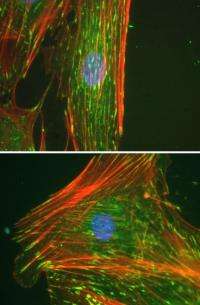Crowding causes cells to produce an orderly matrix of molecules

When researchers conduct experiments on the way cells grow and respond to outside cues, they tend to use solutions that are much more dilute than the crowded environments found inside living cells. Now, new research from MIT shows that this dilute environment may skew the results of such experiments.
Using a technique that more closely mimics the crowded environment in actual cells, researchers found that certain molecules “organize more like we would expect they would in the body,” says Krystyn Van Vliet, the Paul M. Cook Career Development Associate Professor of Materials Science and Engineering at MIT. The research isdescribed this week in the journal PLoS ONE, in a paper co-authored by Van Vliet.
“The cell in the body lives in a very crowded environment,” Van Vliet says. Most researchers have done their work with dilute solutions, which are easier to control and analyze, but have not fully recognized how this may affect the outcomes. It turns out that producing a more crowded environment “induces dramatic alignment of the protein networks outside the cell,” which in turn causes the cell to align its internal structure, she says.
Research approximating “what really happens in the crowded environments” surrounding living cells is virtually “untouched territory,” says Adam Zeiger, an MIT graduate student in materials science and engineering and lead author of the new paper. The research was conducted under the Singapore-MIT Alliance in Research and Technology (SMART), and included SMART postdoc Felicia Loe and professor Michael Raghunath at the National University of Singapore, as well as biological engineering graduate student Ran Li at MIT.
Cells manufacture a matrix that controls the structure of their internal environment, says Van Vliet, who also has an appointment in the Department of Biological Engineering at MIT. “The matrix serves as a template,” she says, sending signaling cues to the cells on how to behave and organize their internal structure. When the matrix-making molecules are studied in vitro in a laboratory environment, they produce disorganized networks, rather than the precisely organized matrices they create in living organisms.
But now, by simply introducing tiny particles — which they call “crowders” — into a lab solution, “we can create the same effect” Zeiger says, causing matrix fibers to align themselves. Using crowders synthesized by Raghunath and Loe, the experiments were carried out on adult stem cells, and the protein that formed the matrix was made of collagen and fibronectin, structural materials that the body uses for connective tissue and skin.
This effect had been predicted theoretically, and has been shown to alter the way proteins form, Van Vliet says, but “we believe that this study is the first to actually show how macromolecular crowding drives the organization and architecture of extracellular networks made by cells.”
The effect is physical, not biological, the researchers say. They proved this by removing the cells from the solution and showing that the proteins still produced aligned structures as long as the crowding particles were in place, even though there was no longer anything alive in the solution. “In the absence of crowders, there’s no alignment,” Van Vliet says. “But with crowders, and no cells present, we see pronounced alignment of the collagen network. This establishes a reciprocal relationship between the cell and the matrix.”
This could ultimately lead to better methods of engineering proteins or tissue scaffolds, Van Vliet says, using such crowded chemical solutions to produce materials for use in grafts or organ replacements. The method might also lead to better ways of using cells as biological factories for the production of pharmaceuticals, nutrients or even structural materials.
But it could also become an important research tool for biology and medicine, she says. Often, results seen in medical research in the laboratory turn out not to work as well in humans or other living organisms; the difference in crowding in the cellular environments may be one significant reason for such discrepancies, she says.
The crowders the team used are a standard, off-the-shelf material used in biological research, but one that had not previously been used in this way. They are tiny spheres (five to 10 nanometers, or billionths of a meter, in diameter) made of polysaccharides, or sugars. The exact composition of the material itself is not as important, Van Vliet says, as is the need for the crowders to be particles of the right size that are not electrically charged and that don’t react biologically with the cell materials. “It’s not a magic molecule,” she says.
It’s also crucial to get the right concentration of the crowders in the solution, Zeiger adds. The effect doesn’t work “if you add too much or too little,” he says, but produces a maximum ordering effect when the concentration of molecules in the fluid “mimics about the levels found in blood” or in the fluid between cells in the body.
“We’re really excited for people to become aware of this work,” Van Vliet says, so other scientists can begin applying the technique to a wide variety of research. “Now, anyone could do this, and we hope that’s what happens. It could become a standard part of cell-culture research and the engineering of cell-material interactions.”
David Weitz, the Mallinckrodt Professor of Physics and of Applied Physics at Harvard University, calls this “a very elegant study,” and says it “confirms the importance of a more realistic environment surrounding stem cells than is typically found when the stem cells are grown on a flat surface in cell medium.” The fact that inert molecules added to the solution have such a strong effect “confirms that more realistic models of the environment of a cell are required, both for studies of cell properties and for any future technological use of stem cells,” he says.
Journal information: PLoS ONE
Provided by Massachusetts Institute of Technology
This story is republished courtesy of MIT News (web.mit.edu/newsoffice/), a popular site that covers news about MIT research, innovation and teaching.


















